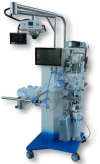Effectiveness of Stabilization of Preterm Infants With Intact Umbilical Cord Using a Purpose-Built Resuscitation Table-Study Protocol for a Randomized Controlled Trial
- PMID: 31106181
- PMCID: PMC6499150
- DOI: 10.3389/fped.2019.00134
Effectiveness of Stabilization of Preterm Infants With Intact Umbilical Cord Using a Purpose-Built Resuscitation Table-Study Protocol for a Randomized Controlled Trial
Abstract
Background: Most preterm infants fail to aerate their immature lungs at birth and need respiratory support for cardiopulmonary stabilization. Cord clamping before lung aeration compromises cardiovascular function. Delaying cord clamping until the lung has aerated may be beneficial for preterm infants by optimizing hemodynamic transition and placental transfusion. A new purpose-built resuscitation table (the Concord) has been designed making it possible to keep the cord intact after preterm birth until the lung is aerated and the infant is respiratory stable and breathing [Physiological-Based Cord Clamping (PBCC)]. The aim of this study is to test the hypothesis whether stabilizing preterm infants by PBCC is at least as effective as the standard approach using time-based Delayed Cord Clamping (DCC). Study design: This is a randomized controlled non-inferiority study including 64 preterm infants born at <32 weeks of gestation. Infants will be randomized to either the PBCC approach or standard DCC. In case of PBCC, infants will be stabilized with an intact umbilical cord and the cord will only be clamped when the infant is considered respiratory stable, defined as the establishment of regular spontaneous breathing, a heart rate ≥100 bpm and oxygen saturation above 90% while using inspired fraction of oxygen (FiO2) < 0.40. The Concord will be used, which allows giving respiratory support with an intact umbilical cord. In the DCC group infants are clamped first before they are transferred to the standard resuscitation table for further treatment and stabilization. Cord clamping is time-based and delayed at 30-60 s. The primary outcome will be the time to respiratory stability of the infant, starting from birth. Secondary outcomes will include details of stabilization, important clinical outcomes of prematurity and maternal safety outcomes. Discussion: We expect that PBCC using the Concord may reduce major morbidities and mortality in preterm infants. The current study protocol will assess the effectivity of stabilization. Once effectivity of stabilization is confirmed, we will start a large multicenter randomized clinical trial to investigate whether PBCC reduces mortality and morbidity in preterm infants compared to the standard approach. Trial registration: Netherlands Trial Registry NTR7194, registered on April 20th, 2018.
Keywords: newborn transition; physiological-based cord clamping; preterm infants; randomized controlled trial; resuscitation; study protocol; umbilical cord clamping.
Figures



Similar articles
-
Physiologically based cord clamping for infants ≥32+0 weeks gestation: A randomised clinical trial and reference percentiles for heart rate and oxygen saturation for infants ≥35+0 weeks gestation.PLoS Med. 2022 Jun 23;19(6):e1004029. doi: 10.1371/journal.pmed.1004029. eCollection 2022 Jun. PLoS Med. 2022. PMID: 35737735 Free PMC article. Clinical Trial.
-
Physiological-based cord clamping in very preterm infants: the Aeration, Breathing, Clamping 3 (ABC3) trial-study protocol for a multicentre randomised controlled trial.Trials. 2022 Oct 1;23(1):838. doi: 10.1186/s13063-022-06789-6. Trials. 2022. PMID: 36183143 Free PMC article.
-
Physiological-based cord clamping in very preterm infants - Randomised controlled trial on effectiveness of stabilisation.Resuscitation. 2020 Feb 1;147:26-33. doi: 10.1016/j.resuscitation.2019.12.007. Epub 2019 Dec 23. Resuscitation. 2020. PMID: 31874212 Clinical Trial.
-
Implementing intact cord resuscitation in very preterm infants: feasibility and pitfalls.Eur J Pediatr. 2023 Mar;182(3):1105-1113. doi: 10.1007/s00431-022-04776-2. Epub 2022 Dec 28. Eur J Pediatr. 2023. PMID: 36575308 Review.
-
Italian Recommendations for Placental Transfusion Strategies.Front Pediatr. 2018 Dec 3;6:372. doi: 10.3389/fped.2018.00372. eCollection 2018. Front Pediatr. 2018. PMID: 30560107 Free PMC article. Review.
Cited by
-
Physiologically based cord clamping for infants ≥32+0 weeks gestation: A randomised clinical trial and reference percentiles for heart rate and oxygen saturation for infants ≥35+0 weeks gestation.PLoS Med. 2022 Jun 23;19(6):e1004029. doi: 10.1371/journal.pmed.1004029. eCollection 2022 Jun. PLoS Med. 2022. PMID: 35737735 Free PMC article. Clinical Trial.
-
Cord management in non-vigorous newborns.Semin Perinatol. 2023 Jun;47(4):151742. doi: 10.1016/j.semperi.2023.151742. Epub 2023 Mar 17. Semin Perinatol. 2023. PMID: 37031034 Free PMC article.
-
Physiological-based cord clamping in very preterm infants: the Aeration, Breathing, Clamping 3 (ABC3) trial-study protocol for a multicentre randomised controlled trial.Trials. 2022 Oct 1;23(1):838. doi: 10.1186/s13063-022-06789-6. Trials. 2022. PMID: 36183143 Free PMC article.
-
Ductal Flow Ratio as Measure of Transition in Preterm Infants After Birth: A Pilot Study.Front Pediatr. 2021 Jul 19;9:668744. doi: 10.3389/fped.2021.668744. eCollection 2021. Front Pediatr. 2021. PMID: 34350143 Free PMC article.
-
Physiological-Based Cord Clamping: When the Baby Is Ready for Clamping.Neonatology. 2024;121(5):547-552. doi: 10.1159/000540667. Epub 2024 Aug 28. Neonatology. 2024. PMID: 39197438 Free PMC article. Review.
References
LinkOut - more resources
Full Text Sources
Miscellaneous

